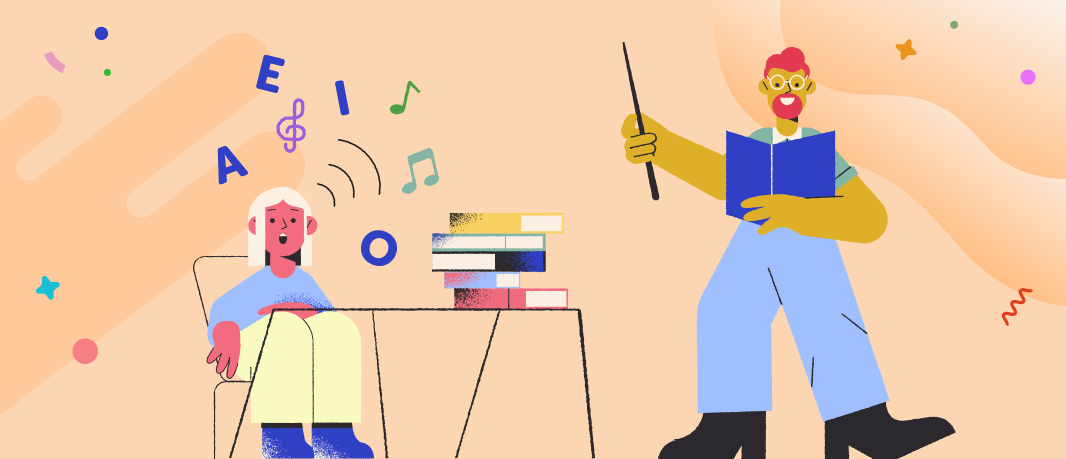Each and every one of us learned to read thanks to a dedicated teacher. When we curl up with our favorite book, we can enjoy the simple pleasure of reading because someone took the time to help us learn our letters and sound out words. Now, for most of us, reading is second nature. Yet teachers of young children know that it isn’t a natural skill. In fact, there are many methods used to teach students how to read.
Today, more and more districts are asking teachers to make a switch in their reading instruction to embrace more research-based teaching methods. As schools and districts begin the process, one particular phrase has come to light–“the science of reading.” Whether you work in literacy or reading programming or with children who are learning to read, it is helpful to understand this term and how it impacts your instruction. Here’s a closer look at what the science of reading is and how Beanstack can support you in implementing it!
What is the Science of Reading
The science of reading is the name given to the research that has been conducted over the last couple of decades about how children learn to read and what motivates them. When teachers understand the complexities involved in literacy instruction, it’s easier to help students gain reading comprehension.
As one of the most important skills students will learn, reading opens doors and introduces students to a world of opportunities. In turn, teachers want to know that the methods they’re using to help students learn to read are working–they want to see their students thrive. This is where the science of reading comes in. Spanning a wide range of fields–cognitive science, educational theory, and the science of the physical brain–the science of reading is research-based and helps ensure the success of students. By understanding what works best for kids, teachers can create proficient readers.
Common Misconceptions About Learning to Read Through Science-Based Reading Instruction
The science of reading is quickly becoming a popular topic in the world of education and is changing the way we look at teaching reading. As a result, there is much talk about the subject. But how do we determine fact from fiction? Let’s take a look at several common misconceptions about learning to read that have been successfully debunked as educators turn to more effective practices.
1. Learning to Read is a Natural Process
Children learn oral language through a natural process, as long as they have speaking adults around them during their infancy. However, they don’t learn to read in the same way. They need to be taught how to read, with clear instructions on the sounds of the language and the way those sounds connect to written words.
2. Children Will Learn to Read If Given Enough Time
Since reading isn’t a natural process, it’s not enough to give students time and wait for them to catch up with their peers. The idea that some students are “late bloomers” has been proven false. If a child has trouble learning to read early on, it may not be because of developmental lag. In fact, waiting to intervene can negatively impact struggling readers. The sooner an educator can pinpoint the skill deficit–such as decoding skills, phonological awareness, or phonemic awareness–the more likely the child will be to overcome it and bloom into a fluent reader.
3. The Science of Reading Only Emphasizes Phonics
Phonics is an important part of reading, but readers also need to understand the words they’re sounding out. The science of reading uses the Simple View of Reading, which has five components, including:
- Phonemic awareness
- Phonics
- Vocabulary
- Comprehension
- Fluency
When all five of these components work together, reading comprehension can be achieved.
4. Science of Reading-Aligned Practices Do Not Encourage Independent Reading
This myth indicates that teachers who follow the science of reading only bring specific texts to the classroom that align with their instructional goals and don’t allow students to read independently with materials they enjoy. However, practices aligned with the science of reading feature different texts for different needs. Students are encouraged to read books they enjoy on their own, and are taught to read other books during specific reading instruction times.
5. Science of Reading-Aligned Practices Do Not Encourage the Joy of Reading
The word “science” paired with “reading” can make people think reading is going to be boring. They may fear that lessons will focus too much on decoding and less on enjoying books. Yet, research actually shows the opposite to be true. Students who are able to decode what they’re reading often find reading more enjoyable and engaging. In turn, the science of reading brings joy to the process, making it fun for all.
What Teachers Should Know About the Science of Reading
When creating a reading program, it’s helpful for teachers to understand the science of reading. This allows them to see how children learn and gives them practical tools they can use to create effective literacy instruction techniques. The results? Improved learning outcomes for students and happy, proficient readers.
So what do you need to know as an educator? One of the most important things the science of reading explains is the three different parts of the reading brain. These are:
- The phonological processor: This part of the brain, which is located on the front left side, decodes spoken language and gives words firm definitions. Babies are born with this area fully intact.
- Orthographic processor: This part of the brain is in the back and to the left. It decodes visual images. Like the phonological processor, it is intact at birth.
- Phonological assembly region: this is the connection between vision and speech. In order for a child to read, they must see words and connect those words to the speech they already understand. This system of connections isn’t present at birth, so it must be developed through a child’s education.
It is in building these connections that the science of reading is helpful. When teachers work to bring each part together, students are more likely to succeed.

How to Implement the Science of Reading
So how does a teacher use this science to teach reading effectively? There are four main components that a teacher should bring to the classroom.
Explicit Instruction
Because reading isn’t a natural process, it requires explicit instruction. Teachers must take the time to teach the complex skills that are required to read. This starts with a lesson presented as a demonstration. After demonstrating the skill, the teacher will practice the skill together with the students. Once the students have completed the guided practice, they will complete the lesson on their own.
Phonological Awareness
Phonological awareness is a child’s ability to recognize spoken words with their sounds, rhythms, and rhyme. This awareness occurs in early pre-reading activities, when children learn how to rhyme words, clap out syllables, and recognize patterns. The earlier a child builds these skills, the greater their success in reading and spelling instruction will be later on. It’s important that students master these skills before moving on to more advanced material.
Systematic Phonics Instruction
Phonics involves teaching children how to recognize the sounds of a word with its letters. It starts with teaching consonants and vowel sounds. It then moves to digraphs, the combination of two letters representing one sound, and blends. Next, students learn how to identify the vowel patterns that make long vowel sounds. Finally, students learn syllable patterns followed by affixes. When presented this way, phonics works well.
Structured Literacy
Students also need structured literacy. This involves putting together phonics with spelling and decoding skills. By doing this in a systematic way, students learn more effectively to read and spell. Students with challenges like dyslexia can also see improved learning outcomes using this method.
Strong Connections and Reading Culture
These components taught independently are important, but the final factor that makes the science of reading work is the connections between the components. Connections between the students in the classroom and each other, and connections between the students and the teacher are also important. Establishing meaningful relationships and building a reading culture can make reading instruction more impactful because it inspires students to read independently and encourages a love of reading.
What Makes An Effective Reading Program
The science of teaching helps build fluency through systematic instruction in the classroom, and creates the foundational skills kids need to learn to read. When paired with an effective reading program and plenty of classroom and at home practice, it can foster a community of readers in no time!
An effective reading program focuses less on student achievement and more on student engagement, helping them develop an intrinsic motivation to read. Using Beanstack can enhance a districts’ reading program and complement literacy instruction in the classroom. Beanstack inspires kids to read by incorporating gamification elements. Instead of moving kids through levels and focusing on quizzes to determine proficiencies, the program rewards them for the reading they want to do. As rewards accumulate, their motivation to continue reading and earning rewards will grow. Gamification makes reading even more fun!
No matter the level of instruction, from elementary to high school, Beanstack helps all readers. Here are some recent case studies of schools that have found success:
- Joy James Elementary School in Fort Worth, Texas increased student achievement by over 60% on standardized tests after using Beanstack.
- Charleston County School District in South Carolina created a reading culture with Beanstack on both elementary and secondary education campuses.
- Mitchell County Middle School in Camilla, Georgia saw Lexile improvements in elementary school grades after implementing Beanstack.
Beanstack’s reading challenges encourage young readers who are working on early literacy skills to read more. Plus, English learners can be rewarded for the reading they do, even if it is slow and steady. Fluent readers are rewarded too. No one gains rewards simply because of their proficiency–students can be placed on a level playing field. This encourages greater participation and inspires a true love of reading.
The science of reading provides a method for evidence-based instruction while Beanstack motivates readers to read more. Used together, they can create a community of readers and help build a balanced literacy approach. Reach out to Beanstack today to schedule a demo, and see how our reading challenges can become an essential element of your early learning instruction in reading.

